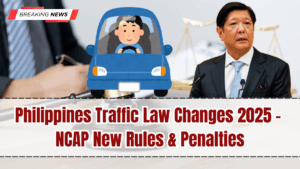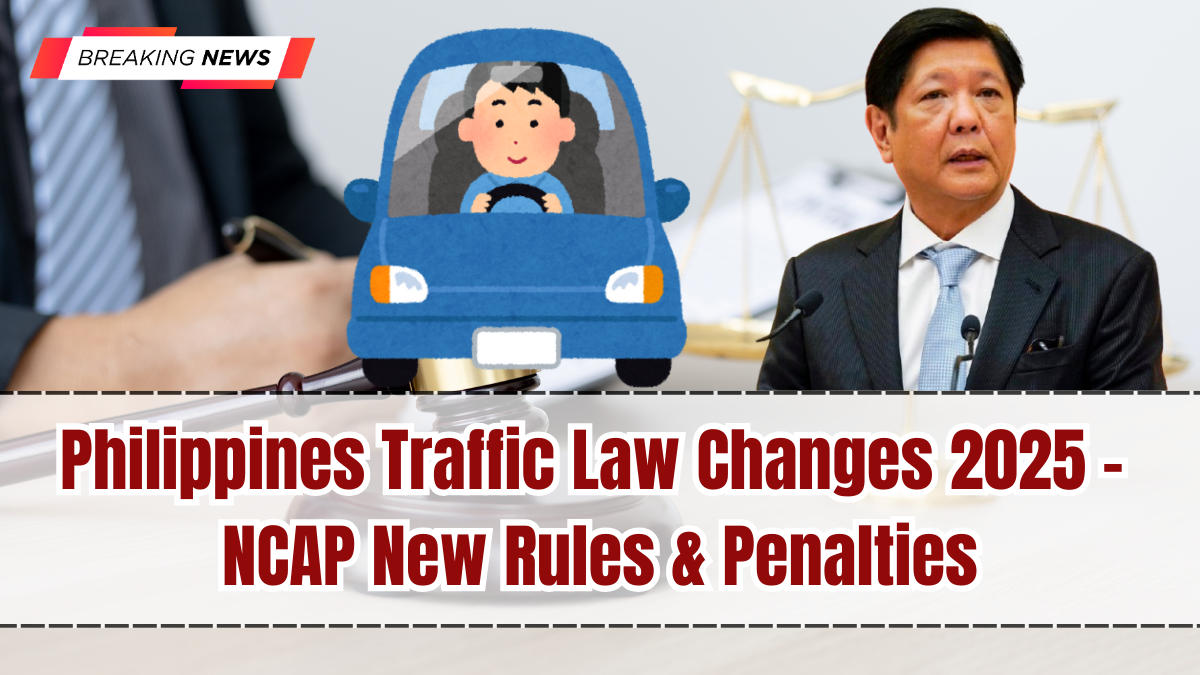The Traffic Law Changes Philippines 2025 update has sparked heated discussions among motorists. The No Contact Apprehension Program (NCAP) is now stricter than ever, with higher fines and tougher enforcement across Metro Manila.
For drivers, this means more vigilance on the road. Cameras are everywhere, violations are tracked instantly, and penalties are automatically charged. Many see it as a step toward safer roads, but others worry about fairness and costs.
So, what exactly has changed under NCAP in 2025, and how will it affect everyday driving? Let’s dive in.

What Is the NCAP and Why Is It Important?
The No Contact Apprehension Program uses high-tech cameras and monitoring systems to detect violations without traffic enforcers physically flagging vehicles.
It was introduced to reduce corruption, improve compliance, and keep roads safer. In 2025, the program has been expanded and upgraded with AI-powered systems that leave little room for error.
What Are the New NCAP Rules in 2025?
Motorists should be aware of the stricter rules introduced this year.
-
Expanded Coverage: NCAP now applies to more cities in Metro Manila, not just Manila, Quezon City, and Parañaque.
-
Higher Fines: Penalties for common violations such as overspeeding and counterflowing have increased by 20–30%.
-
Faster Ticketing: Violations are now sent digitally within 48 hours via SMS and email.
-
License Points: Serious violations under NCAP can now add demerit points to driver’s licenses.
These updates aim to improve road discipline but also increase financial consequences for violators.
How Much Are the New Fines in 2025?
The penalties have been revised to discourage repeat offenses.
-
Overspeeding: ₱2,000–₱3,000 depending on severity
-
Beating the Red Light: ₱3,500
-
Illegal Parking: ₱1,500 per offense
-
Counterflowing: ₱5,000
-
Obstruction of Intersections: ₱2,500
These amounts may seem steep, but authorities argue that higher fines encourage safer driving habits.
How Does the NCAP Process Work?
Drivers caught on camera receive an official violation notice via mail, SMS, or email.
-
The notice includes video or photographic evidence.
-
Motorists must pay fines online, at city hall, or through accredited banks.
-
Unpaid fines can block vehicle registration renewal at the LTO.
This digital system makes enforcement quicker and less prone to bribery or negotiation.
Are Motorists Happy With These Changes?
Reactions are mixed.
Supporters believe stricter NCAP rules will reduce reckless driving, congestion, and accidents. They point out that drivers will think twice before ignoring traffic lights or speeding.
Critics, however, complain about errors in violation notices and argue that higher fines unfairly burden working-class drivers. Some even call for better public transport before stricter enforcement.
How Does NCAP Affect Professional and Public Drivers?
Public utility drivers, including jeepney and bus operators, are among the most affected. With higher fines, even a single violation can cut deep into daily earnings.
Taxi and Grab drivers also need to be extra careful, as fines directly impact profitability. Fleet operators now assign safety officers to monitor violations and train drivers to comply strictly with rules.
Is NCAP Linked to the New Demerit System?
Yes. The LTO’s demerit system now works hand-in-hand with NCAP.
-
Minor violations add 1–2 points.
-
Major violations like counterflowing add 5 points.
-
Accumulating 10+ points can lead to license suspension.
This means violations caught on camera don’t just cost money—they can also endanger your license.
What Should Drivers Do to Avoid Penalties?
The best defense against NCAP fines is discipline and awareness.
-
Always obey speed limits and traffic lights.
-
Park only in designated areas.
-
Check NCAP city websites regularly to verify violation notices.
-
Drive defensively, especially in intersections with heavy monitoring.
With more cameras rolling, the margin for error is shrinking.
Will NCAP Expand Outside Metro Manila?
Yes. The MMDA and LTO have confirmed that by late 2025, NCAP will be expanded to other major cities such as Cebu and Davao.
Regional LGUs are already preparing by installing cameras and drafting ordinances. This could make the system nationwide within the next two years.
Conclusion
The Traffic Law Changes Philippines 2025 highlight a stricter approach to enforcement. With tougher NCAP rules, higher fines, and the integration of the demerit system, drivers must now take compliance seriously.
While the program has its critics, authorities insist it will save lives, reduce congestion, and modernize road safety enforcement. For motorists, the message is clear: drive smart, follow the rules, and avoid costly mistakes.
FAQs
What is NCAP in the Philippines?
It is the No Contact Apprehension Program, which uses cameras to catch traffic violations without on-road enforcers.
How much are the new NCAP fines in 2025?
Overspeeding costs ₱2,000–₱3,000, red light violations ₱3,500, and counterflowing ₱5,000.
Can NCAP violations affect my driver’s license?
Yes. Serious violations now add demerit points, which can lead to license suspension if accumulated.
How do I pay NCAP fines?
Fines can be paid online, at city halls, or through accredited banks and payment centers.
Will NCAP expand outside Metro Manila?
Yes, plans are underway to roll it out in Cebu, Davao, and other major cities by late 2025.
Click here to know more.
